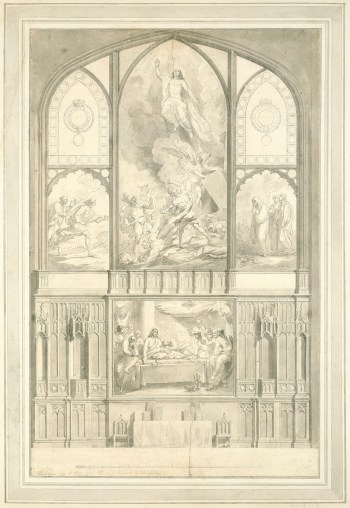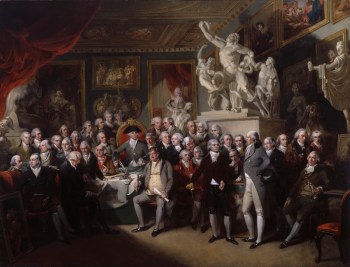Thomas Sandby RA (c.1723 - 1798)
RA Collection: People and Organisations
The architect and draughtsman Thomas Sandby was born in Nottingham. As a young man he and his brother Paul (1731 - 1809), later a renowned watercolourist, were apprenticed to a local land surveyor.
After the death of his father in 1742 Sandby moved to London, where he was engaged as military draughtsman in the Ordnance office. In 1746, he entered the household of William August, Duke of Cumberland (1721 - 1765). Sandby accompanied Cumberland on his campaigns in Scotland and the Netherlands, making military drawings.
In 1746 Cumberland was appointed Ranger of Windsor Great Park, and Sandby was employed to produce views of the grounds. These were sometimes made in collaboration with his brother Paul, both artists playing an important role in the development of watercolour painting in England.
Sandby moved back to London for between 1760 and 1765, and was active in its artistic world. He served on the committee of the newly formed Society of Artists in 1759, and in 1768 was a Founder Member of the Royal Academy. As the Royal Academy’s first Professor of Architecture Sandby delivered an annual series of lectures from 1770 until the end of his life.
In 1764 Sandby became Steward to the Duke of Cumberland and Deputy Ranger of Windsor Great Park. He made numerous plans for improvements and additions to the park and designed a number of private houses in the Windsor area. Little of Sandby’s architectural work has survived (his most-admired work, the Freemason’s Hall in Great Queen Street, London, was demolished in 1932) although his drawings reveal he was a neoclassical designer in the vein of Sir William Chambers (1723 - 1796).
Sandby died in Windsor in 1798, and was buried in the churchyard at Old Windsor. His obituary in the Gentleman’s Magazine stated that “by his decease, the King has lost an honest and valuable servant, the neighbourhood of Windsor an inhabitant universally esteemed, and his family and friends one of the gentlest and best of human beings”.
Profile
Foundation Member
Born: c.1723 in Nottingham
Died: 29 June 1798
Nationality: British
Elected RA: 10 December 1768
Professor of Architecture: 1768 - 1798
Gender: Male
Preferred media: Architecture
Works by Thomas Sandby in the RA Collection
14 results
-

Thomas Sandby RA
Design for a monumental hall: interior perspective, c. 1775
Watercolour on thick laid paper with watermarks
-

Thomas Sandby RA
The Royal Academy annual exhibition of 1792: The Great Room, East Wall, April 1792
Pen and ink with wash on laid paper
-

Thomas Sandby RA
The Royal Academy annual exhibition of 1792: The Great Room, West Wall, April 1792
Pen and ink with wash on laid paper
-

Thomas Sandby RA
The Royal Academy annual exhibition of 1792: The Great Room, North Wall, April 1792
Pen and ink with wash on laid paper
-

Thomas Sandby RA
The Royal Academy annual exhibition of 1792: The Ante-Room, North wall, April 1792
Pen and ink with wash on laid paper
-

Thomas Sandby RA
The Royal Academy annual exhibition of 1792: The Ante-Room, West wall, April 1792
Pen and wash on laid paper
-

Thomas Sandby RA
The Royal Academy annual exhibition of 1792: The Ante-Room, South Wall, April 1792
Pen and wash on laid paper
-

Thomas Sandby RA
The Royal Academy annual exhibition of 1792: The Ante-Room, East Wall, April 1792
Pen and wash on laid paper
-

Thomas Sandby RA
The Royal Academy annual exhibition of 1792: The Great Room, North Wall, April 1792
Pencil on thin laid paper
-

Thomas Sandby RA
The Royal Academy annual exhibition of 1792: The Great Room, East Wall, April 1792
Pen and ink on thin laid paper
-

Thomas Sandby RA
The Royal Academy annual exhibition of 1792: The Great Room, South Wall, April 1792
Pencil on thin laid paper
-

Thomas Sandby RA
The Royal Academy annual exhibition of 1792: The Antique Academy, April 1792
Pencil on thin laid paper
-

Thomas Sandby RA
The Royal Academy annual exhibition of 1792: The Ante-Room, East wall, April 1792
-

Benjamin West PRA and Thomas Sandby RA
Design for the East Window, St. George's Collegiate Chapel, Windsor, 1781?
Pen and ink on wash on paper
Works after Thomas Sandby in the RA Collection
4 results
-

After Thomas Sandby RA
The Pondhead, Cascade, Grotto and Great Bridge at Virginia Water, Windsor Great Park
Line-engraving
-

After Thomas Sandby RA
Design for a Bridge near Somerset Place
Aquatint
-

After Thomas Sandby RA
Hill Hall, in Essex, the seat of Sir W. Smyth, Bt., 1 May 1780
Etching with engraving
-

After Thomas Sandby RA
Wentworth House in Yorkshire, the seat of the Marquis of Rockingham, 1 April 1779
Etching with engraving
Works associated with Thomas Sandby in the RA Collection
4 results
Associated books
7 results
-
George Richardson
A Treatise On The Five Orders Of Architecture, In Which The Principles Of That Art Are Illustrated By Elegant And Correct Examples, Representing The Most Approved Forms, Proportions, And Decorations, Peculiar To The Several Orders; As Exhibited In The Remains Of The Beautiful Edifices Of Antiquity; Composed In The Style Most Consonant To The Orders That Adorn The Magnificent Temples, Baths, Theatres, Amphitheatres, Basilicas, Triumphal Arches, And Other Ancient Buildings. Containing Twenty-Two Plates Engraved in Acquatinta, producing the Spirit and Effect of finished Drawings in Indian Ink; With complete Explanations in English and French, accompanied with Observations made on several of the Antiquities at Rome, and various Parts of Italy, at Pola in Istria, and the southern Provinces of France, in the Years 1760, 1761, 1762, 1nd 1763; By George Richardson, Architect. ... Traité Des Cinq Ordres D'Architecture, Où les principes de cet Art sont exposé dans tout leur jour, au moyen d'examples choisis et corrects qui représent le différens Ordres dans leur plus belle forme, suivant leurs meilleurs proportions, et avec les décorations qui leur sont particulières, d'après ce qui reste des plus beaux édifices de l'Antiquité ... - London,: [1787]
03/2774
-
Jean Lepautre
OEuvres D'Architecture De Jean Le Pautre, Architecte, Dessinateur & Graveur du Roi. Tome Premier. ... (- Tome Troisieme. ...) - A Paris,: [1751]
03/2764
-
Francis Grose
The Antiquities Of England And Wales. By Francis Grose, Esq. F.A.S. Vol. I. (-Vol. IV.) - London.: [1773-1776]
03/2588
-
Sir William Chambers RA
Plans, Elevations, Sections, and Perspective Views Of The Gardens And Buildings At Kew in Surry, The Seat of Her Royal Highness The Princess Dowager of Wales. By William Chambers, member Of the Imperial Academy of Arts at Florence, and of the Royal Academy of Architecture at Paris, Architect To the King, and to Her Royal Highness the Princess Dowager of Wales. - London,: [1763]
03/2522





















